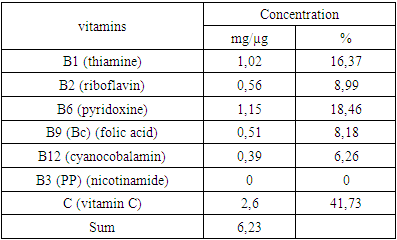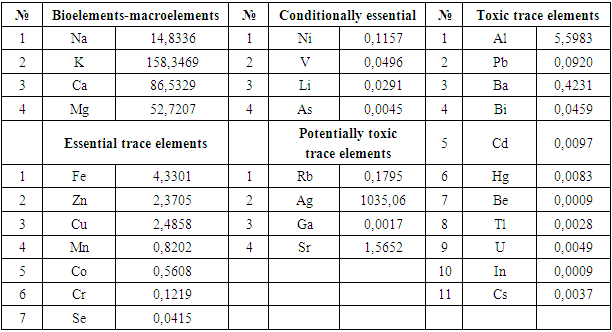-
Paper Information
- Paper Submission
-
Journal Information
- About This Journal
- Editorial Board
- Current Issue
- Archive
- Author Guidelines
- Contact Us
American Journal of Polymer Science
p-ISSN: 2163-1344 e-ISSN: 2163-1352
2022; 11(1): 18-22
doi:10.5923/j.ajps.20221101.03
Received: Aug. 31, 2022; Accepted: Oct. 14, 2022; Published: Oct. 27, 2022

Study of the Elemental Composition and Water-Soluble Vitamins of Cistanche Salsa of Karakalpakstan
Gulsara Berdimbetova, Shakhnoza Orazova, Kuvvat Khajibaev
Karakalpak Scientific Research Institute of Natural Sciences of the Karakalpak Branch of the Academy of Sciences of the Republic of Uzbekistan, Nukus
Correspondence to: Shakhnoza Orazova, Karakalpak Scientific Research Institute of Natural Sciences of the Karakalpak Branch of the Academy of Sciences of the Republic of Uzbekistan, Nukus.
| Email: |  |
Copyright © 2022 The Author(s). Published by Scientific & Academic Publishing.
This work is licensed under the Creative Commons Attribution International License (CC BY).
http://creativecommons.org/licenses/by/4.0/

The content of water-soluble vitamins and the elemental composition of the stolon of Cistanche salsa (Cistanche salsa) growing in Karakalpakstan were studied. Using high-performance liquid chromatography, the presence of 7 water-soluble vitamins (C, PP, B1, B2, B6, B9 and B12) and inductively coupled plasma mass spectrometry - 30 macro- and microelements were established. Among the vitamins, vitamin C is dominant, with vitamin B12 having the lowest content. The quantitative content of the sum of vitamins is 6.23 mg/µl, of which vitamin C accounts for 2.6 mg/µl (41.73%). For saline cistanche, the predominance of macroelements K, Ca is characteristic. Of the microelements, iron and aluminum predominate; an abnormally high content of silver has been established. The concentrations of toxic elements do not exceed the permissible limits for a living organism.
Keywords: Medicinal plant, Cistanche salina, Elemental composition, Microelements, Macroelements, Water-soluble vitamins, Inductively coupled plasma mass spectrometric method, High performance liquid chromatography
Cite this paper: Gulsara Berdimbetova, Shakhnoza Orazova, Kuvvat Khajibaev, Study of the Elemental Composition and Water-Soluble Vitamins of Cistanche Salsa of Karakalpakstan, American Journal of Polymer Science, Vol. 11 No. 1, 2022, pp. 18-22. doi: 10.5923/j.ajps.20221101.03.
Article Outline
1. Introduction
- One of the promising plants for the world pharmaceutical market are plants of the genus Cistanche Hoffmgg. et Link, which belongs to the Orobanchaceae family and, according to [1], includes 27 holoparasitic species. In Uzbekistan, it is represented by 9 species, of which 4 species are found in Karakalpakstan [2,3].This plant has been known since ancient times as being widely used in traditional Chinese medicine. It is registered in the Chinese and Japanese Pharmacopoeias as Cistanches Herba (Rou Cong Rong), an excellent tonic drug obtained from the dried succulent stems of Cistanche deserticola YC Ma or Cistanche tubulosa (Schenk) Wight [4-6]. Its traditional functions include the treatment of kidney failure, impotence, female infertility and senile constipation, and in recent years, the treatment of neurodegenerative diseases [4].Chemical analysis of Cistanches Herba showed that the main constituents are phenylethanoid glycosides, iridoids, lignans, oligosaccharides, and polysaccharides [7-9].Pharmacological studies have confirmed that cistanche has lipid-lowering, estrogenic, neuroprotective, immunomodulatory, antitumor, anti-inflammatory, hepatoprotective, antioxidant, antibacterial, antiviral, and tonic properties [10-13].To date, more than 100 compounds have been isolated from this genus and more than 100 Chinese patent medicines are registered in the Chinese Pharmacopoeia Commission (2015) and other official standards [13].Along with pharmacopoeial species from China, other Cistanche species that grow outside of China, in particular in Kazakhstan and Uzbekistan, have recently attracted the attention of local scientists as a promising raw material resource for the creation of new pharmacological agents and analogues of Cistanches Herba [14-22].It is natural to assume that the therapeutic effect of this medicinal plant may depend not only on the biologically active substances contained in it, but also on the concentration of amino acids, vitamins, macro- and microelements, information on the quantitative content of which in plants of the genus Cistanche is rare or absent [21-23].The possibility of using cistanche growing on the territory of Karakalpakstan as a source of raw materials for the isolation of biologically active substances and the production of herbal preparations dictates the need to study its main and secondary metabolites, macro- and micronutrients.Previously, we reported on the study of macro and microelements (underground and aboveground parts, and seeds) and the amino acid composition of the stolon of Cistanche salina from Karakalpakstan [19,20].In this paper, we present the results of studies of the elemental composition and water-soluble vitamins of stolons of Cistanche salsa, growing in the southern region of Karakalpakstan.Earlier, we briefly noted the relevance of research and the role of macro- and microelements in the biochemical processes of the human body [19]. Equally important are vitamins, which are low molecular weight organic compounds of various chemical nature and structure, synthesized mainly by plants and partially by microorganisms [24].The main role of vitamins is to ensure the normal course of biochemical and physiological processes by participating in the regulation of metabolism. Vitamins are not included in the structure of human and animal tissues and are not used as an energy source.In the human body, some vitamins are not synthesized completely, others are synthesized by the intestinal microflora and tissues in insufficient quantities, and therefore the body must constantly receive vitamins from food or directly, or their closest biochemical precursors - provitamins, which in human and animal organisms are easily converted into vitamins [24].It should be noted that no food product contains all or even most of the vitamins, each group of products serves as a source of individual vitamins. The lack of vitamins, or their lack in the body, leads to the development of various diseases - hypo- or avitaminosis, and in the case of microelements, microelementoses. Considering that plants are the main source of vitamins, research on the vitamin composition of medicinal plants, along with other biologically active substances, is relevant [25,26].The qualitative and quantitative composition of vitamins, as well as macro- and microelements of most medicinal plants of Karakalpakstan, including cistanche species, are not studied.Therefore, we considered it expedient to supplement our research on the saline cistancha, growing in stressful, environmentally unfavorable conditions of Karakalpakstan, with the determination of its vitamin and elemental composition.
2. Materials and Methods of Research
- The objects of our study were the stolons of Cistanche salsa collected in April 2022. in the flowering phase in the Kipchak territory of the state forestry "Nazarkhan" of the Republic of Karakalpakstan. When harvesting stolons, the plant was dug up, cleaned with a brush from the ground, the inflorescences were separated from the stems, which were washed lightly from the remnants of dirt in running cold water. The dried plant stolons were cut transversely into thin slices. Drying was carried out by the air-shadow method, spreading the cut raw materials in one layer on racks of nylon nets, periodically turning. The analysis of water-soluble vitamins of stolons of Cistanche salina was carried out by high performance liquid chromatography (HPLC), on an Agilent Technologies 1200 chromatograph on an Exlipse XDB C18 column (reversed phase), 3.5 μm, 4.6x150 mm. Diode array detector (DAD), 254, 290 nm. Solution A: 0.5% acetic acid, pH 1.7: B: CH3CN (acetonitrile). Flow rate 1 ml/min. Gradient %B/min: 0-5min/96:4%, 6-8min/90:30%, 9-15min/80:20%, 15-17min/96:4%. Thermostat 250C.The elemental composition was analyzed using inductively coupled plasma mass spectroscopy (ICP-MS) on a Perkin Elmer ISP-MS instrument (Nexion 2000) using a multi-element standard for 29 elements and a Hg standard. Preliminary sample preparation was carried out using a Berghoff microwave decomposition system with MWS-3+ software (Germany).
3. The Discussion of the Results
- The content of 7 water-soluble vitamins was determined in the studied sample of the stolon Cistanche salsa (Cistanche salsa), growing in Karakalpakstan, using high-performance liquid chromatography:The results of the study on the study of the qualitative and quantitative content of vitamins by HPLC are presented in Fig. 1 and in Table 1.
 | Figure 1. Хроматограмма витаминов столонов Cistanche salsa |
|
|
4. Conclusions
- Thus, the study of water-soluble vitamins of the stolon of Cistanche salina, growing in stressful, environmentally unfavorable conditions of Karakalpakstan, showed that medicinal raw materials can serve as a raw material source of vitamins C and B.As a result of the analysis of the macro- and microelement composition of the stolon of the saline cistanche growing in the southern region of the Republic of Karakalpakstan, it can be stated that its quantitative composition is significantly inferior to the content of the elements of the saline cistanche from the northern regions of the republic.The accumulation of toxic trace elements has been found to meet regulatory requirements or are contained in safe trace amounts.The obtained results indicate the need to continue research on the chemical composition of Karakalpakstan species of the genus Sistanche Hoffmgg. et Link depending on the place and growing conditions to assess the prospects for their practical use as herbal remedies.
 Abstract
Abstract Reference
Reference Full-Text PDF
Full-Text PDF Full-text HTML
Full-text HTML
